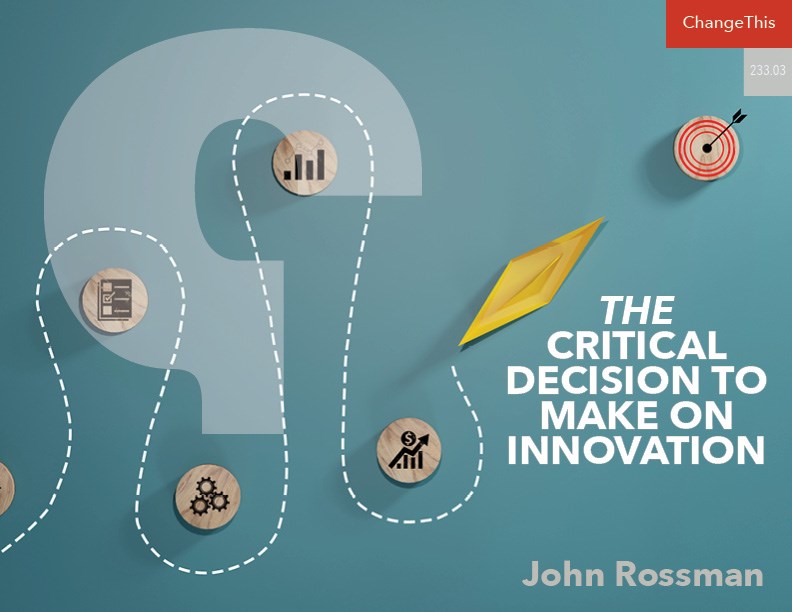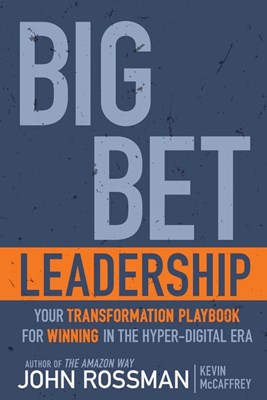The Critical Decision to Make on Innovation
February 21, 2024
Innovation is not a spontaneous occurrence, but something that can be developed with the right systems in place, according to leadership strategist John Rossman.
I enjoy any sport done at an expert level.
I am enthralled by smaller Olympic sports like bobsledding, water polo, swimming, archery, badminton, or the biathlon. For an athlete to simply get to the Olympics is an incredible achievement and testimony to years of competition, training, and sacrifice coupled with natural talent. There are no guarantees—work, talent, progress and rankings mean nothing until the championship moment, won or lost.
Like an elite athlete getting a gold medal and having the pride of hearing their national anthem played, executives all want championship moments in their businesses. They seek to consistently deliver outstanding business results in terms of revenue growth, increasing profitability, and defensible differentiation from the competition—this is “winning”.
No one questions whether innovating, in all its flavors—product innovation, process innovation, business model innovation, is needed to achieve these championship moments. But do they realize that they actually have to go to the “sweaty gym” every day, build fitness and form and suffer defeat to become better, just to have the chance at glory? Do they realize that it takes years of having your “training system” in place to build for these championship moments?
Do they have a long-term system for innovation, or is “hope” the real plan for innovation?
A SET OF QUESTIONS
To evaluate how your organization has answered the critical question, here’s a diagnostic, a way to understand your answer to the one question. You could do this as a survey as input to a strategic conversation on innovation in your business:
- Do we have a deliberate, repeatable, measured approach for seeking and reviewing new ideas in the business?
- Do we only or primarily select “ideas” that we understand well and have high confidence in their success (low-risk concepts)?
- Do we have a one-size-fits-all approach for how projects are delivered?
- Do risky ideas ( or “bets”) employ an agile and MVP (minimally viable product) approach, seeking early customer participation and feedback?
- Do we have written processes, funding and dedicated leadership focused on innovation across different horizons?
- Do we have a portfolio management philosophy for our innovation investments?
- Does the business have a balanced scorecard of metrics on innovation & growth including both innovation output metrics (such as % of revenue from products launched within the past two years or customer adoption of new business models) and innovation input metrics (such as the number of horizon 3 and horizon 2 ideas proceeding through experimentation)?
- Do the board and senior leadership have an agenda focused on innovation and include key metrics from a sustained innovation system?
Discuss these questions and you’ll know the honest answer to “do I have a system for innovation?”
KEY ELEMENTS OF A SYSTEM OF INNOVATION
There are many “right” answers for the end-state system of innovation to which a business might aspire, as well as multiple paths to get there. The specific plan needs to be tailored to the current context of the business, the culture, and the ambition. But there is a set of three innovation elements that must be in place for innovation to become systematic.
Innovation Element #1 — Think in Bets
A “bet” is an idea believed to have impactful future potential to gain customers and deliver a financial return, but you can’t prove it. It’s a hypothesis for a new concept. There are many aspects or factors of the idea yet to be proven and if any of them should fail, the idea will likely fail also. For example, while the concept of the particular customer experience may sound great, we don’t understand what the unit costs might be or how to predict adoption. These types of ideas are “bets” and it’s important to recognize that these types of ideas are the critical input to the rest of your system for innovation.
“Think in Bets” infers that ideas need to be captured. Ideas need to be vetted. Decisions need to be made about which ideas are carried forward into the next key element.
Innovation Element #2 — Experiment
In whatever form or methodology of “agile” development and minimally viable product approach you chose, the key is “speed” — speed in experimenting; speed to testing; speed to learning; speed in making decisions; speed on the next iteration. When it comes to innovation, the cost of delay should be considered the most important cost to manage, yet it’s regularly ignored.
But companies are typically good at one thing which negatively impacts the Experiment element—they slow ideas down. Companies slow down ideas because of the processes which must be followed, because of how resources are allocated, because of how other initiatives are planned, and in making it (experimentation) a true priority for executives. The real challenge here is finding deliberate approaches and strategies to counteract this natural orientation and to put in place catalysts for creating speed in experimentation.
Innovation Element #3 — Build a Portfolio Strategy
Much like a VC firm, if the bets and associated incremental investments are small and fast, the job is to both manage the portfolio and to make the best decisions about each bet at the right time. The portfolio can be evaluated based on horizons (h1, h2, h3), risk & reward, adjacencies, problem types, and many other criteria. The key is to realize that there is a portfolio and that the portfolio needs to be aligned with other aspects of corporate strategy.
For larger organizations, the task at the corporate level becomes more like that of an endowment manager, overseeing a “portfolio of portfolios.” There may be multiple individuals in the organization accountable for managing the performance of their portfolios of bets, with room for an enterprise role in managing bets across portfolios. This approach enables more decentralized decision-making and avoids turning portfolio management into a decision-making bottleneck by funneling all bets through a small number of time-constrained decision-makers.
BACK TO YOUR KEY DECISION
The power of one committed decision should not be underestimated. Do we optimize for this quarter’s profitability, or for long-term growth? Are we willing to “fail” in our experiments, or do we only allow for only successful outcomes, in effect prioritizing only incremental improvements and safe ideas? Are ad-hoc approaches for evaluating and launching new products and business models going to satisfy our growth ambition?
So it really does come down to this one question—
Do we create a system for innovation— or just HOPE that innovation happens?
What’s your answer?



